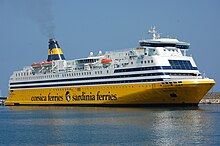Superstructure
This article needs additional citations for verification. (January 2013) |


A superstructure is an upward extension of an existing structure above a baseline. This term is applied to various kinds of physical structures such as buildings, bridges, or ships.[1]
Aboard ships and large boats
On water craft, the superstructure consists of the parts of the ship or a
The size of a watercraft's superstructure can have many implications in the performance of ships and boats, since these structures can alter their structural rigidity, their displacements, and/or stability. These can be detrimental to any vessel's performance if they are taken into consideration incorrectly.
The height and the weight of superstructure on board a ship or a boat also affects the amount of freeboard that such a vessel requires along its sides, down to her waterline. In broad terms, the more and heavier superstructure that a ship possesses (as a fraction of her length), the less the freeboard that is needed.
Bridges
The span of a bridge, the portion that directly receives the live load, is referred to as the superstructure. In contrast, the abutment, piers, and other support structures are called the 'substructure'.[2]
Earthquake protection
In order to improve the
References
- ^ Mane, Vikrant (2023-01-19). "Superstructure in Building Construction". Civil Engineering Notes. Archived from the original on 2023-01-31. Retrieved 2023-01-31.
- OCLC 366744.
